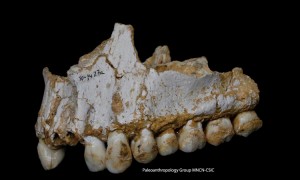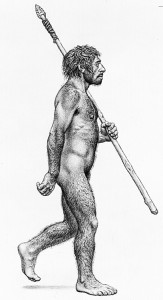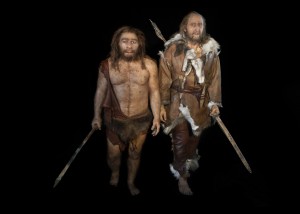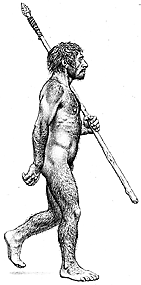Revealing the Neandertal Diet
Friday, March 10th, 2017March 10, 2017
Hard gunk stuck in the teeth of fossil Neandertal jaws shows that the prehistoric human beings had a widely varied diet and a sophisticated knowledge of medicinal plants. Scientists analyzing dental calculus (a hard, yellowish substance formed by the buildup of plaque between teeth) from three Neandertal fossils found dramatic differences in diet and evidence that Neandertals likely used some foods as medicine. The scientists’ findings were published in the March 8 issue of the journal Nature.

The teeth of this fossilized Neandertal jaw revealed traces of poplar bark, a source of aspirin. The individual had also consumed Penicillium mold, source of the natural antibiotic penicillin. Credit: © Paleoanthropology Group MNCN-CSIC
Neandertals were prehistoric human beings who lived in Europe and central Asia from about 150,000 to 39,000 years ago. They looked quite different from modern humans. Neandertal skulls were huge compared to ours, with a projecting face; no chin; a low, sloping forehead; and a thick browridge (raised strip of bone across the lower forehead). Because Neandertals had such a brutish appearance, people long assumed the these prehistoric humans possessed only a crude and simple culture. However, new evidence shows they were perhaps smarter than we previously thought.
An international team of scientists examined three fossil Neandertal skulls dating from 42,000 to 50,000 years ago. Two of the skulls were from El Sidrón, a cave in Spain, and one was from Spy Cave in Belgium. The teeth of these fossils were coated with thick layers of hardened dental calculus. The scientists knew that this material preserves DNA from microbes and food debris that pass through an individual’s mouth during their lifetime. The dental calculus of the Spy Neandertal contained traces of meat from wooly rhinoceros and wild sheep, while evidence of plant foods was largely absent. In contrast, the two Spanish Neandertal fossils appeared to have survived on a vegetarian diet of edible moss, mushrooms, tree bark, and pine nuts.

Neandertals lived in Europe and Central Asia from about 150,000 to 39,000 years ago. Credit: © Jay H. Matternes
Other evidence showed that the El Sidrón Neandertals probably also used plants for medicine. The scientists recovered DNA from poplar trees in the dental calculus. While not eaten for food, these trees contain salicylic acid, the pain-relieving ingredient in aspirin. Preserved spores of the Penicillium mold, from which the life-saving antibiotic penicillin is produced, were also recovered. The scientists think the Neandertals ate the plant sources for their medicinal properties. One fossil skull showed evidence of a painful tooth infection, and DNA from a microbe known to cause stomach problems was also recovered from the calculus. Aspirin and penicillin would have helped.
Neandertals died out about 39,000 years ago, when physically modern human beings migrated into Europe. However, Neandertals did not disappear completely. Genetic evidence shows at least some Neandertals interbred with modern-looking populations that settled Europe, Asia, and the Pacific Islands. Neandertals are extinct, but they remain part of the ancestry of some modern peoples today.




